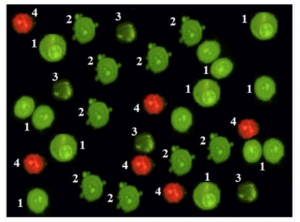
Many figures in four papers by a research team in Malaysia contain duplication or manipulation, a university committee has found, calling for multiple retractions.
We learned about issues with three of the papers, including one in Scientific Reports, earlier this week when they were the talk of Twitter. As journals issued expressions of concern, and an expert wondered how the papers passed peer review at all, the first author, a researcher at the University of Malaya (UM), denied allegations of duplication.
UM was alerted to allegations of misconduct in the Scientific Reports paper last Saturday, and according to a statement published today:
The committee concluded that there were duplication and/or manipulation of almost all the figures (images and graphs) within the original Scientific Reports paper and across three other publications authored by the group of researchers.
As the University of Malaya adheres to a strict policy of research integrity and ethical practices, the authors have been asked to retract all the four published articles immediately.
Further to this investigation appropriate disciplinary action will be taken according to the University’s policies. University of Malaya regrets that this incident has occurred on a tradition of the University’s continuing emphasis on academic and research excellence.
It’s remarkable that UM worked so quickly to weigh in on the issue, since in our experience, these deliberations often drag on for months or years, with little information from the universities.
UM vice-chancellor Prof Tan Sri Dr Mohd Amin Jalaludin said the findings from the investigation suggests that all four articles were prepared by a single set of data.
The Higher Education Minister in Malaysia told The Star on Tuesday that he is also investigating allegations concerning the papers.
Two of the four papers, in PeerJ and Frontiers in Pharmacology, have earned expressions of concern. A spokesperson for Scientific Reports told us yesterday:
We would like to clarify that we investigate every concern that is raised with us carefully and will take action where appropriate.
We have not yet confirmed the title of the fourth paper that was investigated by UM, but a statement from the UM Vice Chancellor in The Star suggests that it was published in Recent Patents on Anticancer Drug Discovery.
Hat tip: fendi
Like Retraction Watch? Consider making a tax-deductible contribution to support our growth. You can also follow us on Twitter, like us on Facebook, add us to your RSS reader, sign up on our homepage for an email every time there’s a new post, or subscribe to our new daily digest. Click here to review our Comments Policy. For a sneak peek at what we’re working on, click here.
How refreshing. Quick decisive action by a University.
A unambiguous message that scientific conduct will not be tolerated.
While the image manipulations are easy to detect in this case, how different is the misconduct than other Photoshopped manipulations that are just slightly more difficult to document?
Agreed!
I also agree. A specialist in Photoshop can do amazing works very difficult to detect.
I believe this post is missing a “doing the right thing” tag ?
Either way, kudos to UM for their swift action on this.
Swift action? Yes. Image damage control? Yes.
Sure of course “damage control.”
But, credit where it’s due.
Most universities or other institutions the calculus would come out to ignore, obsfucate, stonewall and if they can punish the whistleblowers.
Point is that what these authors did was only more obvious but no less wrong than the more skilled image manipulator and other that cheat to get ahead – by that I mean win grants and pile up pubs.
There are some interesting discussions on pubpeer about papers from the same group (including some author responses).
https://pubpeer.com/publications/33BDB1EFE4BCFA44268BDA1EB23530
https://pubpeer.com/publications/ED3D5AFCB9BACC5A62E9799C920AD2
Also see this paper in pubpeer:
https://pubpeer.com/publications/25985394
This is perhaps a more sophisticated way of misconduct with IF images